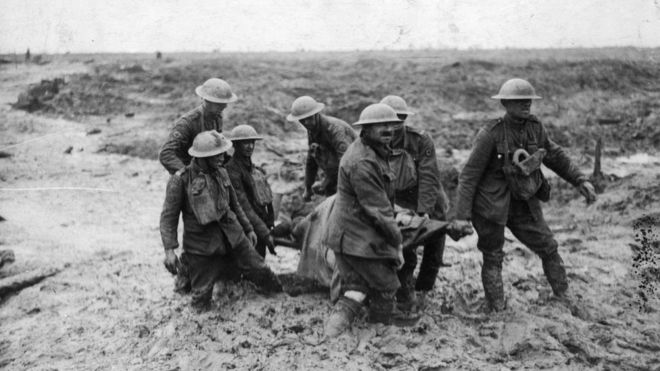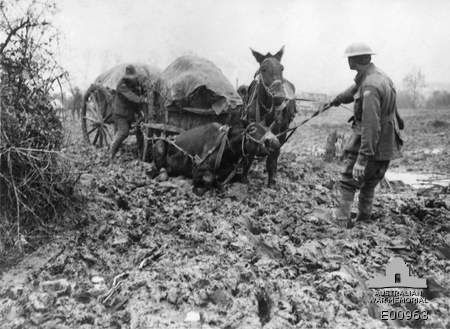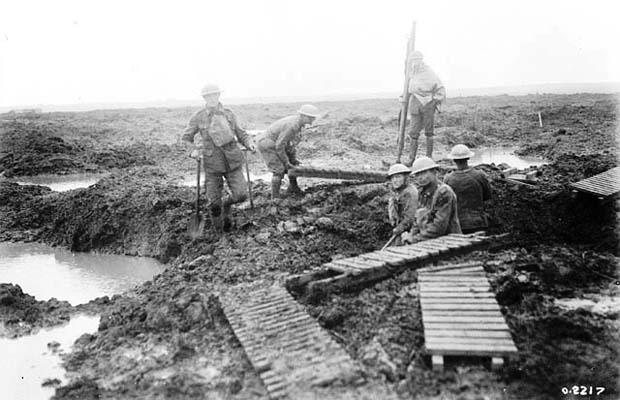Fighting and Dying in The Low Countries.
Seeking a Breakthrough Where None Exists.
Special to The Great War Project.
(31 July) Passchendaele. A tiny village in Belgium. Soon to be the site of a new British offensive a century ago.
This in and of itself does not distinguish the clashes there from so many other battles on the Western Front. “There were plenty of guns to be heard,” writes historian Adam Hochschild. “More than 3000 of them firing off more than four million shells.”

The muck and the mud landscape at Passchendaele.
This artillery bombardment resembles so many other British offensives in this corner of Europe, feeding the hope that it can score a significant breakthrough.
At Passchendaele, there is no such hope. Reports Hochschild, “No new strategy or weapon of any sort distinguished this attack.”
“But there followed,” writes Historian Norman Stone, “one of the most extraordinary episodes of this or any war.”
Rain. Rain fell for seven straight days, with no letup.
“In the end, what separated Passchendaele from the great paroxysms of bloodshed that preceded it was one gruesome fact no one had planned for: in addition to falling victim to German fire, thousands of British soldiers, nowhere near the sea, drowned.”
Hochschild explains: “It was for good reason that this part of Europe had long been known as the Low Countries. The water table is less than two feet below ground in much of Belgium.”
It seems the British command had given no thought to the way a British bombardment would wreck canals and drainage ditches.
“And,” Hochschild explains, “this leaved tens of thousands of craters that soon filled with water.”
The area is covered in mist, Hochschild reports, “as the assault began in the early morning of July 31st a century ago. The mist soon turned into non-stop rain,” the heaviest in years, it was reported, “the heaviest in some thirty years.”

Horses sink up to their haunches.
“Observation aircraft could not take to the sky, weapons jammed, and the clay soil of the watery moonscape of craters became sticky. Guns could barely be moved, and mules and horses pulling ammunition wagons sank up to their stomachs and had to be dug out.”
“Ambulances carrying wounded soldiers skidded off slippery roads.”
A British soldier’s greatcoat is not waterproof. “It absorbed mud and water like a relentless sponge, adding thirty-four pounds to its weight. As the battle continued, one single day saw 26,000 casualties.”
Writes one officer: “The mud is not so much mud as a fathomless sticky morass. The shell holes, where they don’t actually merge into one another, are divided only by a few inches of this glutinous mud. The gunners work thigh deep in water.”
Some artillery pieces sink out of sight. As do dead soldiers. One soldier writes, when you stop in this mud, and feel something under your feet, it is the body of the man who has fallen before you, a victim of the relentless dreadful mud.
The smell from decaying corpses is unbearable.

The futility of the fighting at Passchendaele.
But inch by inch, the British, Australian, and Canadian forces close in on Passchendaele. Soldiers joke it’s time to bring in the Royal Navy.
The result? Hochschild reports, “Of the more than 88,000 casualties in this sector, named the Ypres sector for the village at its center, no one knows how many fell off the carts and drowned.”
“Belgian farmers still uncover their bones to this day.”
